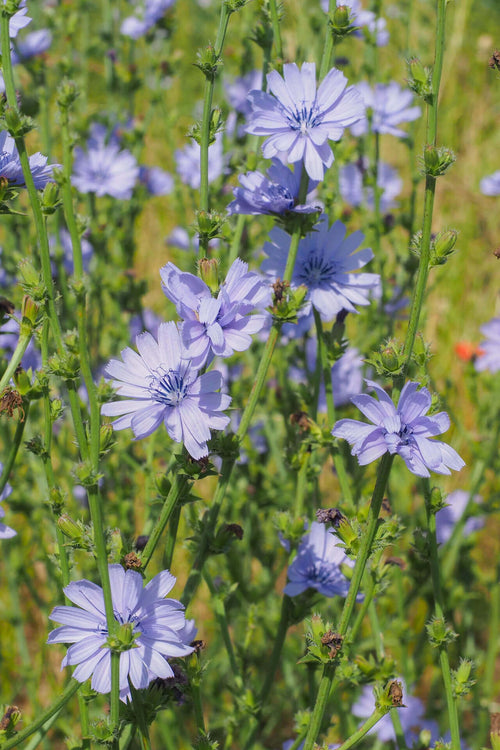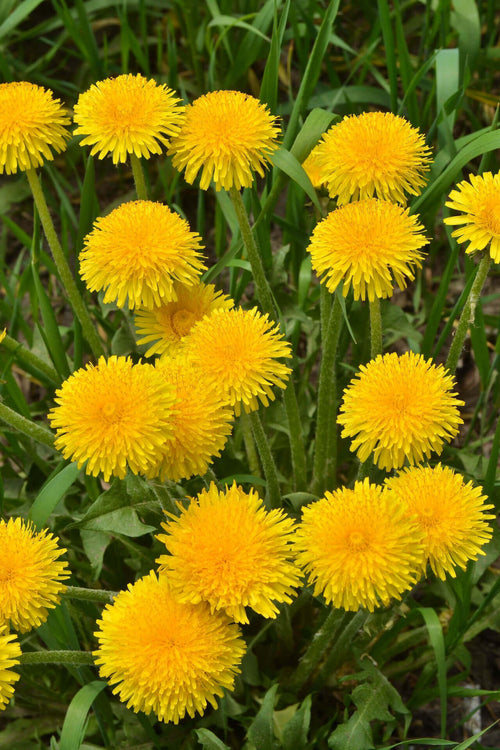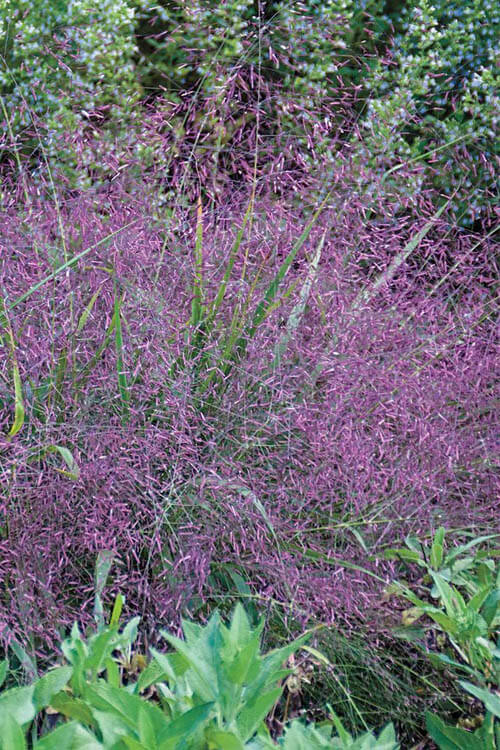*Please research plants independently to verify and ensure dietary safety
Annual vs. Perennial: What’s the Difference?
Annuals are plants that grow, bloom, seed, and die-off in a single year
Perennials are plants will grow and rebloom every year
What are Perennial Herbs?
Herbs are edible plants that are valued for their culinary and/or medicinal value. For centuries, people have used these plants to treat illnesses, ailments, and injuries. Historically, herbs have been used to flavor teas, cooked dishes, salads, and were simply eaten plain.
Most edible herbs are annuals. This means that they die when the frost comes and have to be replaced each year. This list, however, is all about perennial herbs. All of these herbs will return year after year!
Benefits of Growing Perennial Herbs:
- They have a long life, some can live for decades
- While the vegetative growth may die back in winter, new growth will appear in spring
- Unlike annual herbs, perennial herbs don’t have to be dug up and brought indoors for winter
- You can have access to herbs year-round that you have grown yourself
- Many of these perennial herbs can be divided to make more plants to keep or give away to friends and family
Most of the plants on this list are easy to grow and propagate. They can be added to vegetable gardens, ornamental flower beds, or can be grown in containers.
Whether you are looking to try a new perennial herb for yourself, or are searching for the perfect gift for a gardening friend, you have come to the right place.
If you have ever wanted to impress others with your cooking, this list has plenty of culinary surprises.
We have herbs that can be used to make warm soups for the winter or fresh salads in summer. Whether you are looking for new tea leaves to try or want to spice up your DIY beer brewing, this list won’t let you down.
List 9 Perennial Herbs:
- Bird’s Foot Violet (Viola pedata)
- Bishop Weed (Aegopodium podagraria)
- Bluets (Houstonia caerulea)
- Chicory Plant (Cichorium intybus)
- Dandelion Herb (Tara xacum)
- Spotted Wintergreen (Chimaphila maculata)
- Wintergreen Plant (Gaultheria procumbens)
- Wild garlic (Allium ursinum)
- Yarrow Plant (Achillea millefolium)
That was the list of our top perennial herbs. Keep reading for an in-depth description of each plant.
Bird’s Foot Violet (Viola pedata)
Bird’s foot violet grows on woodland edges, meadows, and on embankments. This perennial herb gets its name from its shape and of course, its color. While it grows low, it adds vibrance to the garden. For best results, we recommend mulching them in the fall.
Grow Zones: 4-8
Uses: Can be eaten raw or cooked and used in soups, teas, and jams
Edible Plant Parts: Young leaves and flower buds
Benefits: Can help with headaches and colds
You can order Bird's Foot Violet here
Bishops Weed (Aegopodium podagraria)
Bishops weed, or ground elder, can be used as an ornamental or as a perennial herb. It looks great in borders and grows up to three feet tall. This plant attracts beneficial insects and is excellent in minimizing soil erosion. Because it has a creeping habit, it can make an ideal container plant.
Grow Zones: 4-9
Edible Parts: Leaves and seeds
Uses: Soups, salads and other cooked dishes
Benefits: High in Vitamin C
Bluets (Houstonia caerulea)
Bluets are an easy-to-grow perennial herb. Its flowers have four points on them with blue edges and white centers. As long as you plant them in loose soil, they will pretty much take care of themselves! While bluets have tiny flowers, butterflies are drawn to them.
Grow Zones: 3-8
Uses: Teas, salads
Edible Plant Parts: Flowers
Benefits: Promotes bladder health
You can order Bluets here
Chicory Plant (Cichorium intybus)
The chicory plant has been used as a culinary and medicinal plant for over two thousand years. It can grow over 12 inches tall and prefers full sun. Not only is it easy to grow, but it's also inexpensive!
Grow Zones: 3-9
Edible Parts: Leaves and roots. The flower is edible, but bitter.
Uses: Coffee substitute, cooked dishes, and salads
Benefits: the roots and leaves of this plant can be used in cooking and add a pleasant, spicy flavor to dishes.
You can order your Chicory Plant here
Dandelion Herb (Tara xacum)
Dandelion is one of the most misunderstood plants. For starters, it is not a weed but an herb. For centuries, people have been capitalizing on dandelions' benefits. In addition to being nutritional to humans, the dandelion prevents soil compaction and provides pollinators with much-needed food.
Grow Zones: 3-9
Uses: Teas, coffee, salads, smoothies, general cooking
Edible plant parts: All parts of the dandelion are edible
Benefits: Dandelion is high in Vitamins A, C, and K. It contains magnesium, calcium, iron, and potassium. It is high in antioxidants and may have anti-inflammatory properties.
Spotted Wintergreen (Chimaphila maculata)
The spotted wintergreen is an eye-catching plant with tiny, white flowers. It is grown both as an ornamental and a perennial herb. It does best in full shade and grows no taller than twelve inches.
Grow Zones: 3-8
Uses: Tea
Edible Plant Parts: Leaves
Benefits: Some claim that spotted wintergreen helps with stomach issues and arthritis
You can order Spotted Wintergreen here
Wintergreen Plant (Gaultheria procumbens)
The wintergreen plant, which is related to the spotted evergreen, prefers part sun to part shade. Native to woodlands in eastern North America, the wintergreen is a low-growing perennial herb. Part of the mint family, this tiny plant packs a big punch!
Grow Zones: 3-7
Uses: Tea (leaves) and fruit (berries)
Edible Plant Parts: Leaves and berries (Do not consume berries if you are allergic to Aspirin)
Benefits: Some reported benefits include pain reduction and breath freshening
Wild garlic (Allium ursinum)
Wild garlic has skyrocketed in popularity in recent years, especially in French cuisine. Because it is similar to regular garlic, it can be used in many dishes. This pollinator-friendly plant is easy to grow and has a life span of five to six years. Wild garlic is currently in high demand, but have no fear– it is easy to propagate!
Grow Zones: 3-9
Uses: Can be used like typical garlic
Edible Plant Parts: Scapes, stem, and bulb
Benefits: Wild garlic has been found to have antiviral, antimicrobial, antioxidant, anti-inflammatory, and anti-cancer benefits
You can order Wild Garlic here
Yarrow Plant (Achillea millefolium)
Yarrow is an unfussy, low maintenance perennial herb. It can tolerate varying light and soil conditions. At its peak, yarrow can grow up to three feet. Its showy flowers bloom later in the summer giving pollinators a late-season food source.
Grow Zones: 3-9
Uses: Leaves can be eaten raw or cooked and can be used in mouthwashes, salads, soups, teas and as a flavoring for beer
Edible Plant Parts: Leaves
Benefits: Reduce sinus, nasal, and allergy problems
You can order Yarrow Plant here
If you like soup and salad or want to brew a coffee substitute, there is a perennial herb for everyone on this list. You won't have to worry about replanting and you'll be able to enjoy it for years to come. Whether it is for your own garden or for a loved one, a perennial herb will be the gift that keeps on giving.





























































